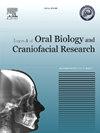用印楝和姜黄提取物绿色合成纳米银及其植物介导纳米银的抗菌活性
Q1 Medicine
Journal of oral biology and craniofacial research
Pub Date : 2025-02-17
DOI:10.1016/j.jobcr.2025.02.005
引用次数: 0
摘要
纳米银纳米颗粒的绿色合成因其对环境的友好性和成本效益而受到人们的关注。本研究利用天然还原剂和封盖剂印楝和姜黄提取物合成银纳米颗粒,重点研究了这些纳米颗粒的特征,并评估了它们对口腔病原体的抗菌性能。材料与方法:采用蒸馏水加热、过滤法制备姜黄和姜黄提取物。将提取液与硝酸银溶液混合,搅拌反应24-48 h。通过紫外可见光谱、SEM、EDAX和XRD分析对所得纳米颗粒进行表征。采用琼脂孔扩散法检测纳米颗粒对4种口腔病原菌的抑菌活性。结果通过颜色变化和表征分析证实了银纳米粒子的成功合成。紫外可见光谱在440nm处出现峰值,表明纳米颗粒形成。扫描电镜显示球形和均匀的纳米颗粒,而EDAX证实了银的存在。XRD分析表明,所制备的纳米颗粒呈结晶性质,粒径在4 ~ 14.81 nm之间。纳米颗粒对金黄色葡萄球菌、变形链球菌和乳杆菌具有显著的抗菌活性,但对白色念珠菌的抗菌效果较差。结论研究表明,印楝和姜黄提取物对绿色合成纳米银具有明显的抑菌活性。这项研究强调了植物介导合成在开发环保型抗菌药物方面的潜力。本文章由计算机程序翻译,如有差异,请以英文原文为准。
Green synthesis of silver nanoparticles using neem and turmeric extract and its antimicrobial activity of plant mediated silver nanoparticles
Introduction
The green synthesis of silver nanoparticles has gained attention for being environmentally friendly and cost-effective. This study investigates the synthesis of silver nanoparticles using neem and turmeric extracts, which serve as natural reducing and capping agents, with a focus on characterizing these nanoparticles and assessing their antimicrobial properties against oral pathogens.
Materials and methods
Neem and turmeric extracts were prepared by heating their powdered forms in distilled water, followed by filtration. The extracts were then mixed with a silver nitrate solution, and the reaction was stirred for 24–48 h. The resulting nanoparticles were characterized using UV–Visible spectroscopy, SEM, EDAX, and XRD analysis. The antimicrobial activity of the nanoparticles was tested against four oral pathogens using the agar well diffusion method.
Results
Successful synthesis of silver nanoparticles was confirmed by a color change and characterization analyses. UV–Visible spectroscopy showed a peak at 440 nm, indicating nanoparticle formation. SEM revealed spherical and uniform nanoparticles, while EDAX confirmed the presence of silver. XRD analysis showed the crystalline nature of the nanoparticles, with sizes ranging from 4 nm to 14.81 nm. The nanoparticles exhibited significant antimicrobial activity against Staphylococcus aureus, Streptococcus mutans, and Lactobacillus species, but were less effective against Candida albicans.
Conclusion
The study demonstrates the effectiveness of neem and turmeric extracts in the green synthesis of silver nanoparticles, which exhibited notable antimicrobial activity. This research underscores the potential of plant-mediated synthesis for developing eco-friendly antimicrobial agents.
求助全文
通过发布文献求助,成功后即可免费获取论文全文。
去求助
来源期刊

Journal of oral biology and craniofacial research
Medicine-Otorhinolaryngology
CiteScore
4.90
自引率
0.00%
发文量
133
审稿时长
167 days
期刊介绍:
Journal of Oral Biology and Craniofacial Research (JOBCR)is the official journal of the Craniofacial Research Foundation (CRF). The journal aims to provide a common platform for both clinical and translational research and to promote interdisciplinary sciences in craniofacial region. JOBCR publishes content that includes diseases, injuries and defects in the head, neck, face, jaws and the hard and soft tissues of the mouth and jaws and face region; diagnosis and medical management of diseases specific to the orofacial tissues and of oral manifestations of systemic diseases; studies on identifying populations at risk of oral disease or in need of specific care, and comparing regional, environmental, social, and access similarities and differences in dental care between populations; diseases of the mouth and related structures like salivary glands, temporomandibular joints, facial muscles and perioral skin; biomedical engineering, tissue engineering and stem cells. The journal publishes reviews, commentaries, peer-reviewed original research articles, short communication, and case reports.
 求助内容:
求助内容: 应助结果提醒方式:
应助结果提醒方式:


